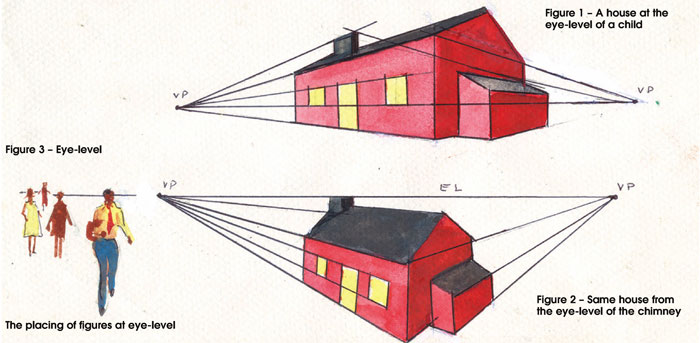|
Learn to draw by Tissa Hewavitarane
The linear perspective
Many art students say defiantly that they do not know anything about
'perspective.' What is implied is that they do not want to study it.
They feel that the word is beyond comprehension. Many books have been
written about the laws of perspective, but you need only to know the
basics.

The first thing we need to establish is the artist's eye level which
will determine the horizon in the picture. For most people the horizon
is where the earth meets the sky, but for the artist, it is at the
eye-level, intersecting with an imaginary eyeline running straight ahead
from the eye.
Therefore if the artist is sitting, the eye level will be lower than
if he is standing. So too is the horizon. The various elements in your
painting will be partly or fully above or below your eye level. In most
cases the main part of the picture will be above the eye level. Having
understood that, the next thing to know is the vanishing point.
This is always on the horizon and it is the spot where all the
parallel lines seem to meet. In many cases the vanishing point will
actually be outside your painting. Now to perspective itself. There are
three different sorts but they are easy to understand. There is one
point perspective which is where all the parallel lines seem to coverage
to a single vanishing point.
This occurs mainly when you are painting interiors but the drawings
will show what I mean. The two point perspective is the most common,
which is when the horizon, as when you are painting a house you can see
two sides.
The last is the three point perspective but it is not much used
unless you happen to be painting a skyscraper from above or a church
tower from close to its base. Study the examples shown here. (Figure 1)
- A house seen at the eye level of a child. Notice the eye line half way
up the door. (Figure 2) - Some houses seen from the eye level of the
chimney. Notice the way of locating the top of the gable. (Figure 3) -
The placing of human figures on the eye-level.
It is useful to know how to divide a plane in half, if you want to
find the position of the top of a gable on a house. Draw two diagonal
lines from the corners of the plane and where they meet will be the
halfway point in perspective. Regarding the drawing of figures or
animals in perspective there are figures in the foreground, middle
distance and in the distance. You will need to draw them so that the
horizon cuts them at eye level with sitting figures a little lower.
Think of perspective not as an adversary, but something that can be
studied at any moment. |

